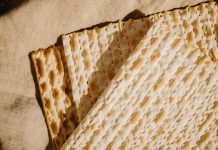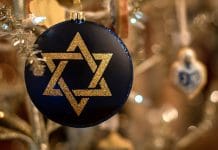
“What’s a camel doing in the closet—in the winter, in Maine?” The camel, I told the children in my daughter’s class, had come all the way from the Middle East, where our religion began. She was too big to fit into a chimney, so she came right in through the front door, and the coat closet right beside that door seemed the most obvious place for her to leave the presents. We don’t have a Santa who comes down a chimney, I explained. The camel is the one that brings gifts on our Baha’i celebration of Ayyam-i-Ha. So I concluded my presentation, and the children dug in to the sugar cookies my daughter and I had made with a special cookie cutter shaped like a nine-pointed star.
A season of hospitality, charity, and gift giving in preparation for the Baha’i fast—the celebration of Ayyam-i-Ha is only a century and a half old. As members of a new religion, my husband and I were used to inventing our own holiday traditions. But when our daughter was born, we had to think hard about what we would do to celebrate this unique holiday. How could the celebration be made to compete with the more established and much-publicized holidays of Christmas and Hanukkah? And how would we connect our present-day celebration here in Maine with the world in which our faith was born more than a century ago?
Enter the camel. The camel was not our own idea. We found the creature in a children’s book* written by a Baha’i author, clearly to show her own children that Ayyam-i-Ha could be just as exciting an occasion as the better known gift-giving celebrations. We learned from the book that the camels carrying goods in caravans were female and they travelled mostly at night, to avoid the desert heat.
The camel, then, would be a “she” and she would deliver her load at night. And unlike Santa who comes down the chimney only once a year, our beleaguered camel would have to visit the closet at least four times a year (five in leap year)–once on each of the days of Ayyam-i-Ha. But we soon learned that four (even five) trips from the Middle East were not enough to deliver all the little gifts we had made and collected over the course of the year, so the camel found its way to the closet twice each day, in the hour just before dawn and in the hour after sunset, but always when it was dark.
The days of Ayyam-i-Ha are also called intercalary days—literally, days “inserted” into the Baha’i calendar, a solar calendar of 19 months, each 19 days long. These intercalary days are extra days, special days, and, in a sense, days outside of ordinary time. As the only Baha’i family in our town, we wanted to reach out to our community by holding an event that embodied the unique spirit of Ayyam-i-Ha. So one year we booked the community hall, hired a caller and some fiddlers and held a community contra dance, with crafts and games for the children and lots of food for everyone.
By the time my daughter reached kindergarten, I had discovered another Baha’i children’s book.** This one told the story of a young girl’s simple and spontaneous plans for celebrating each day of this special holiday. I decided to read the book to my daughter’s class during my annual presentation on Ayyam-i-Ha. Then it occurred to me that the central character, Maggie, with her overalls and wild, red hair, would make a perfect puppet. And each of the special activities Maggie planned for the days of Ayyam-i-Ha would be easy for my daughter to present in a puppet show.
We went down into the basement and found an old kitchen cupboard. My husband cut the back out of it. We bought some red paint, hemmed a piece of green gingham, ran a string through it, and tacked the ends of the string to the sides of the cupboard. Behold: a puppet theater! And it even had doors in the back that could be opened and closed, so we could hide our props and ourselves before the puppet show began.
We searched the toy box for props—a rubber pig for Maggie’s piggy bank, a plastic hammer for breaking it open, a pine cone for Maggie’s bird feeder, a miniature flower pot in which to grow the flowers Maggie gives to her family members and her teacher, and a small tin for the cookies Maggie makes for her neighbors—and before we knew it, we were done. The show ran for six years, and each year, the children were most enthralled by the same scene: the opening one in which Maggie welcomes in Ayyam-i-Ha at sunset on February 25th with a “dance of jubilation” and a prayer of celebration:
My God, my Fire and my Light! The days which Thou hast named the Ayyam-i-Ha in Thy Book have begun, O Thou Who art the King of names, and the fast which Thy most exalted Pen hath enjoined unto all who are in the kingdom of Thy creation to observe is approaching.
When my daughter’s classmates grew too old to enjoy a simple puppet show created for a kindergarten class, we dreamed up other traditions, such as a “tree of life” party during which my daughter and her friends cut out and decorated symbols drawn from a variety of religions—for example, the Star of David, the Christian cross, the Muslim crescent moon, and, of course, the Baha’i nine-pointed star—and hung them on a tree that could be shared by all the peoples of the world.
Now that my daughter is older, my husband and I feel the need to create new traditions, ones that will engage her teenage imagination. The puppet theatre sits in the attic as does the “tree of life,” but we are confident that other ways to celebrate the holiday will emerge in time. And until they do, at least one tradition remains.
Each year, on the first day, of Ayyam-i-Ha, a friend, whose son was in my daughter’s kindergarten class, calls to ask if we are going out to watch the sun set on the first evening of Ayyam-i-Ha. And if the weather is not too dismal, and we can actually see the sun, we all sip hot chocolate as we watch the sun go down. Then we all listen, with joyful anticipation, as one of us recites a familiar prayer:
My God, my Fire and my Light! The days which Thou hast named the Ayyam-i-Ha in Thy Book have begun, O Thou Who art the King of names, and the fast which Thy most exalted Pen hath enjoined unto all who are in the kingdom of Thy creation to observe is approaching.
*Holt-Fortin, Cher. The Ayyam-i-Ha Camel (Kalimat Press: Los Angeles, 1989).
**Tomarelli, Patti Rae. Maggie Celebrates Ayyam-i-Ha (Bellwood Press: Evanston, 2000).



































Thank you for sharing your creative ways to celebrate Ayyam-i-Ha. My family also celebrates it, and one of our traditions, in addition to a gift per day and creative meals is a simple gift for all their teachers (and administrators, past teachers, aids – anyone we have a relationship with at their school). Usually it’s a perennial flower in a little pot with an appreciation for their work inspiring our children and a quote like “So powerful is the light of unity that it can illuminate the whole earth” or “You are the leaves of one tree and the fruits of one branch.” It’s definitely harder once they’re in high school, but I find that the exertions we made when they were younger linger as sweet memories of the holidays even as 15 and 17 year olds – and they can be involved in thinking of new traditions!
I’m so glad to read that Maggie was part of your Ayyam’i’Ha celebrations over the years.
Patti Rae Tomarelli
Wow. Thank you so much!!!! Too late for the sunset on the 25th, but I’ll remember it for next year and definitely using some of your ideas for these wonderful days!
[…] There are no prescribed ways of celebrating Ayyam-i-Ha. Baha’is have sought to avoid specific rituals that are not mandated in their scriptures and they have resisted commercializing their holidays. Baha’i families invent their own beautiful traditions each year for the four days of the celeb… […]
[…] Ideas for Celebrating at Your Child’s School This Baha’i mom raised her daughter in rural Maine, without much of a Baha’i community. To help educate her daughter’s class about their faith, she prepared a puppet show and some other wonderful ideas, which she details in this awesome post. […]